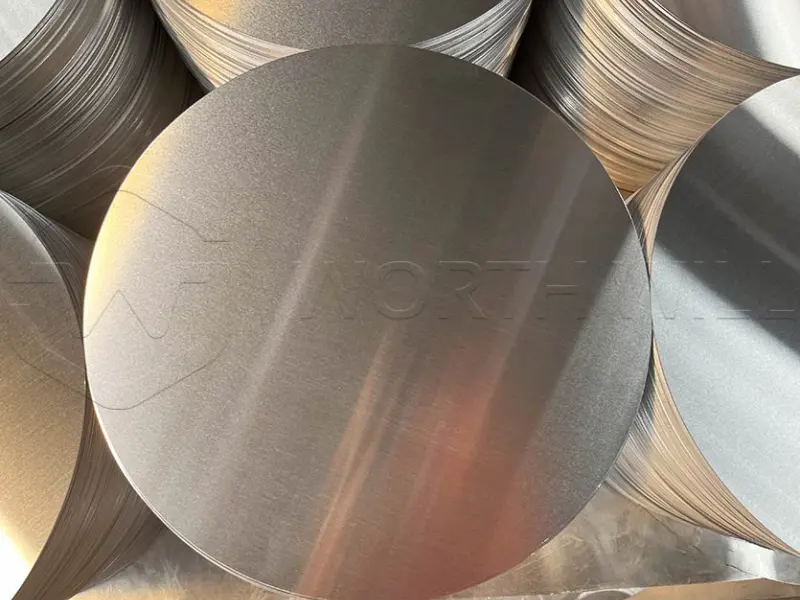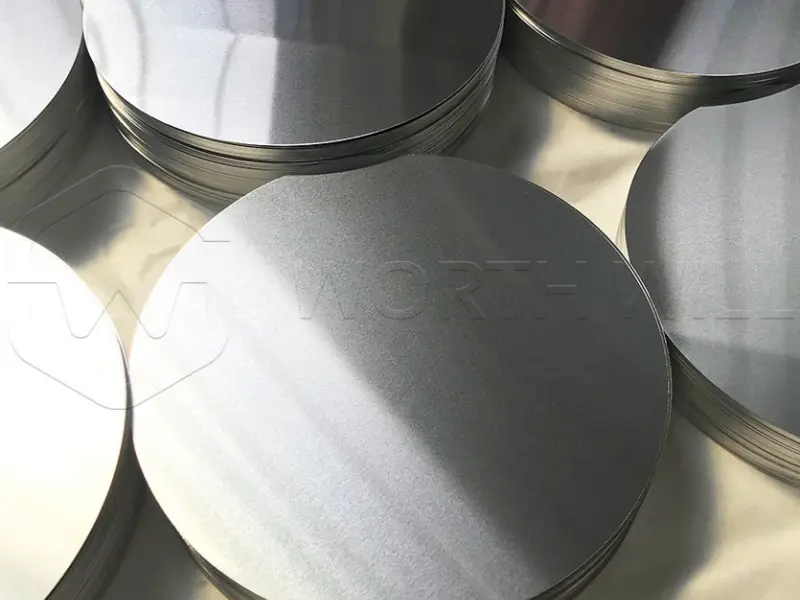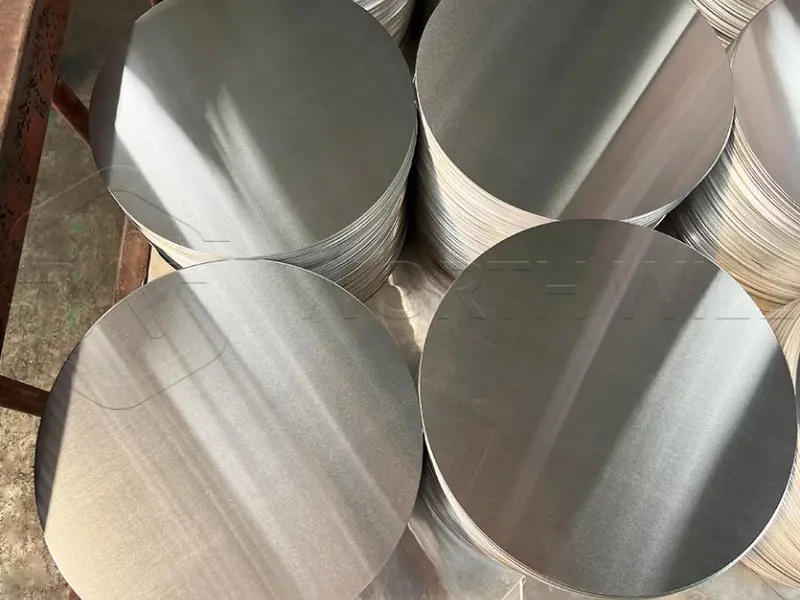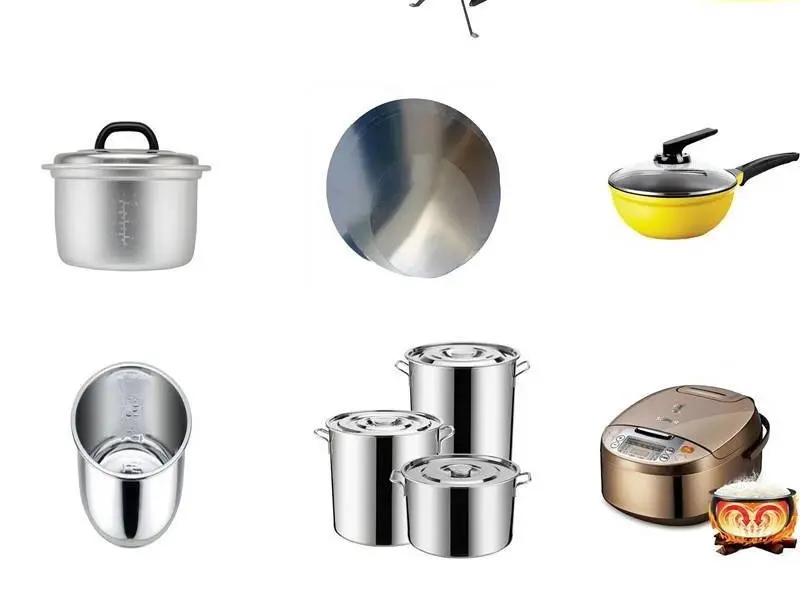What is 3003 Aluminum Circle?
3003 aluminum circle is a manganese-alloyed aluminum disc specifically designed for utensil manufacturing. It offers:




Excellent formability and deep drawing properties
Good corrosion resistance
Non-toxic and food-safe material
Natural anti-bacterial surface
Key Specifications
| Parameter | Specification |
|---|---|
| Alloy | 3003-H14, 3003-H24 |
| Thickness | 0.5mm – 6.0mm |
| Diameter | 100mm – 1200mm |
| Temper | O (annealed), H12, H14, H18 |
Material Properties
| Property | Value | Significance for Utensils |
|---|---|---|
| Tensile Strength | 110-145 MPa | Durability in daily use |
| Elongation | 8-15% | Excellent formability |
| Hardness | 40-75 HB | Scratch resistance |
| Thermal Conductivity | 150 W/m·K | Even heat distribution |
Common Utensil Applications


Cookware:
- Pots and pans bases
- Pressure cooker bodies
- Baking trays and sheets
- Saucepan bottoms
Kitchen Tools:
- Cooking lids
- Strainer baskets
- Steamer plates
- Skillets and griddles
Food Preparation:
- Mixing bowls
- Measuring cups
- Cake molds
- Serving trays
Specialty Items:
- Camping cookware
- Commercial kitchen equipment
- Hotel service items
- Catering containers
Manufacturing Processes
Deep Drawing:
- Suitable for complex shapes
- Minimal material waste
- High production efficiency
- Consistent thickness maintenance
Spinning:
- Ideal for circular items
- Low tooling cost
- Flexible design changes
- Small batch production
Stamping:
- High volume production
- Precise dimensions
- Quick process time
- Cost-effective for simple shapes
Surface Treatment Options
| Treatment | Application Method | Benefits |
|---|---|---|
| Polishing | Mechanical buffing | Smooth surface finish |
| Anodizing | Electrochemical process | Enhanced hardness |
| Coating | Non-stick application | Easy food release |
| Brushing | Abrasive brushing | Decorative finish |
Quality Standards
Food Safety:
- FDA compliance
- EU food contact approval
- ROHS certification
- LFGB testing passed
Performance Standards:
- ASTM B209 material standard
- ISO 9001 quality management
- SGS testing reports
- Material traceability
Advantages Over Other Materials
| Material | Advantages of 3003 Aluminum |
|---|---|
| Stainless Steel | Better heat conduction, lighter weight |
| Cast Iron | Lighter, non-rusting, faster heating |
| Carbon Steel | Non-rusting, easier maintenance |
| Copper | Lower cost, lighter weight |
Design Considerations
Thickness Selection:
- 0.5-1.0mm: Lightweight utensils (lids, covers)
- 1.0-2.0mm: Medium duty (pots, pans)
- 2.0-4.0mm: Heavy duty (pressure cookers)
- 4.0-6.0mm: Commercial grade equipment
Diameter Guidelines:
- 100-300mm: Small items (cups, small pans)
- 300-600mm: Medium items (standard pots)
- 600-900mm: Large items (stock pots)
- 900-1200mm: Extra large (commercial equipment)
Cost Factors
| Factor | Cost Impact |
|---|---|
| Thickness | Thicker = higher cost |
| Diameter | Larger = higher cost |
| Quantity | Volume discounts available |
| Surface Finish | Polished = +20-30% cost |
*Price range: $3-15 per piece depending on specifications*
Maintenance and Care
Cleaning:
- Use mild detergent
- Avoid abrasive cleaners
- Hand wash recommended
- Dry immediately after washing
Usage Tips:
- Avoid extreme temperature changes
- Use wooden or silicone utensils
- Store in dry conditions
- Regular inspection for damage
FAQ
Q: Is 3003 aluminum safe for cooking?
A: Yes, it’s FDA approved for food contact and non-toxic
Q: Can it be used with induction cooktops?
A: Not directly – requires magnetic stainless steel base
Q: How does it compare to 1050 aluminum?
A: 3003 has better strength and formability
Q: What’s the lifespan of utensils made from 3003?
A: 10-15 years with proper care
Q: Can it be recycled?
A: Yes, 100% recyclable without quality loss
Conclusion
3003 aluminum circle is an excellent choice for utensil manufacturing due to its:
Superior formability for complex shapes
Food-safe properties for cooking applications
Excellent thermal conductivity for even heating
Cost-effectiveness for mass production
When selecting 3003 aluminum circles for utensils:
- Choose appropriate thickness for intended use
- Consider surface treatment requirements
- Verify food safety certifications
- Select proper temper for manufacturing process